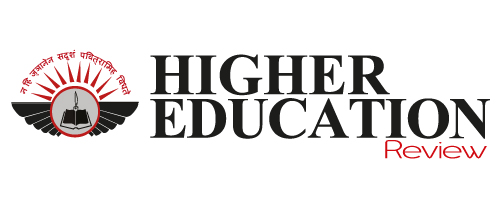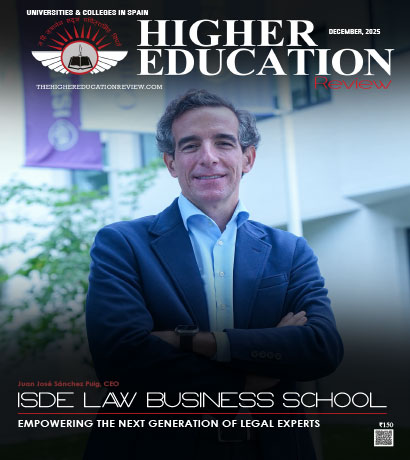Strategic Role of Administration in Enhancing Institutional Excellence
 Ajitesh Basani, Executive Director, ABBS School of Management, during an interaction with Higher Education Review, shares valuable insights on the role of efficient administrative strategies in defining institutional excellence. Also, he elaborates the importance of internal quality frameworks, the significance of lean and decentralized structures, industry-integrated programs, and the changing role of administrative leadership in promoting innovation, collaboration, and high-performance culture in higher education.
Ajitesh Basani, Executive Director, ABBS School of Management, during an interaction with Higher Education Review, shares valuable insights on the role of efficient administrative strategies in defining institutional excellence. Also, he elaborates the importance of internal quality frameworks, the significance of lean and decentralized structures, industry-integrated programs, and the changing role of administrative leadership in promoting innovation, collaboration, and high-performance culture in higher education.
How can effective administrative strategies contribute to the overall excellence of an institution?
One of the considerations in administration is how efficiently systems work and how well the systems are integrated into a higher education institution. Effective strategies can make the entire higher education process a lot more efficient or simpler. Part of the initial actions would be ensuring that the right people, those who understand the administrative structure, are there. It is a general belief that only people with an academic background are capable of performing such tasks, but non-academics can also perform administrative tasks efficiently if they are aware of the systems. After the proper team is established, setting up an Internal Quality Assurance Cell (IQAC) becomes extremely useful.
Administrative processes get more effective once the operational work is executed on a day-to-day basis. Governing body meetings must be organized once or twice a year by institutions. Besides these, it will also be important to create some key bodies, such as an Academic Council and a Board of Examinations. In addition to maintaining administration, it is important that day-to-day activities run smoothly and the right people are put in charge of the right key job roles.
What are the key administrative practices that directly impact institutional growth and innovation?
In terms of institutional growth, one of the most common problems higher education faces is the existence of hierarchical structures. After a decision has been made, it can take a significant period to get approval and go ahead with execution. Having a leaner, decentralized structure helps in moving a lot quicker. The innovation is highly dependent on the programs being offered. Institutions have to consider whether they are offering something new, unique, or more aligned with present academic and industry needs. So, we introduced KPMG to our financial modeling program for MBA students. Similarly, we introduced the Bombay Stock Exchange for undergrad students, as well as PGDM students, same area of financial modeling. Right now, we are in the middle of finalizing an IBM-integrated program for our MBA business analytics students and the BBA and BCA students.
The whole point is keep up certain percentage or number of credits that the industry can directly give to the students which makes a lot of difference in terms of get direct inputs. While faculty members are typically strong in teaching fundamental concepts and specialized knowledge but at advanced levels, it requires the involvement of practitioners who are directly involved in real-world work.
In what ways can the role of administration be redefined to foster a culture of continuous improvement in institutions?
Listening to stakeholders is an important aspect of continuous improvement, especially at a higher education. Establishing an Internal Quality Assurance Cell (IQAC) is important since it allows for the gathering of feedback from stakeholders and helps to determine what is being done now is effective or not.
For continuous improvement, particularly in higher education, listening to stakeholders is important. Setting up an Internal Quality Assurance Cell (IQAC) is necessary because it allows the institution to gather input from stakeholders and helps to determine whether what is being done now is effective or not. Without consistent input from parents, students, teachers, and others, institutions may be run on false assumptions - assuming they are doing the right thing when in fact they may not. Continuous feedback ensures that decisions are based on real needs and experience.
A further essential element in building a culture of improvement is having well-defined goals. There is always the opportunity to learn from what is being done by other institutions worldwide. Looking at their practices, learning about the benchmarks they operate under, and assessing whether such benchmarks can be applied in one's situation can make an important contribution toward continuous improvement and learning. The core pillar here is the faculty. Although many faculty members are aware of emerging technologies such as AI, they may not understand them. It is vital to provide these new technologies in a platform that gives them a pathway to learning and growing, which will help them to become more efficient, and it also opens up in learning from various departments.
How does strategic administration help in aligning institutional goals with long-term academic and organizational success?
Strategic management requires clarity, long-term thinking, and planning. Having a clear vision and mission contributes significantly to overall success. But whatever we are doing today is a build-up towards the end of being a university that makes a direct impact on society, not one that gives degrees, but one that specializes in areas where society needs experts or people who can make a difference. So, long-term planning does make a huge difference. Simultaneously, the leadership has an important role to play in dictating or showcasing what the institution must become. It is important to be very clear on how long the process will take and to understand how much of what we are currently doing has a direct impact on that goal.
For example, in engineering, after graduation, whatever students learn in four years, in two years becomes redundant, because technological change is so fast, that the skill sets that they learn become less important, and very few things are carried forward to their careers. We want to focus on those learning cycles and envision a future where degrees can be stackable, rather than completed as one large, traditional degree. You can earn a certificate, diploma, or degree, giving you the ability to move in and out of the education system. It is a student-centered way of doing things.
What role does administrative leadership play in promoting collaboration and resource optimization within an institution?
ERP system is fundamental to any institution since it optimizes resources and gives visibility into activities in progress. Institutions are mostly developed with an integrated model instead of a departmental focus, so most of the resources become shared facilities like labs and shared areas. The sharing of such spaces and services greatly increases operational efficiency. Another equally significant aspect is to provide faculty members with the right platforms for research, as this increases collaboration. A collaborative research paper by faculty members from the biotechnology and management streams can lead to impactful insights.
One very special initiative we have adopted is encouraging collaboration between students and faculty in research, particularly at the MBA and PGDM levels. By the second year, students tend to collaborate on research papers with the faculty members. Here, the faculty member either can be a first author or a mentor for the student. This kind of collaboration extending beyond faculty-to-faculty partnerships to faculty-to-student partnerships have turned out to be very successful in the progress of research and developing good outcomes.
How can institutional administration support the development of a high-performance culture among faculty, staff, and students?
To build a high-performance culture, it has to begin with acknowledging high performance. This is important because not recognizing accomplishments can lead to demotivation. Yet another important point when making a professional and high-performance environment is to schedule workshops, seminars, and Faculty Development Programs continually. These programs give opportunities to interact with the external world and experts who are conducting new and impactful research. Moreover, another unique aspect that helps students is mentoring. We organize mentorship with both industry experts and faculty members to lead students in the right direction. These basic things help in ensuring that high-performance cultures are always met.
What are the challenges faced by the administration in driving institutional excellence, and how can they be overcome?
Each time we try to bring in change, it is resisted, as people do not easily embrace new methods. Also, higher education is tightly regulated at various levels - university, state, and central—so these restrictions are difficult to navigate. This regulation slows the pace of progress; it keeps one from doing things at their speed and needs to conform to the speed established by these regulatory bodies.
The most difficult part is finding the balance between innovation, compliance, and regulatory needs. At one end of the line is innovation and creativity, while at the other end is efficiency and compliance with regulation. It's a balancing act between being more efficient and more focused on innovation. While it is a difficult challenge, one can deal with it by using transparent communication systems and technology, especially for operational tasks.

